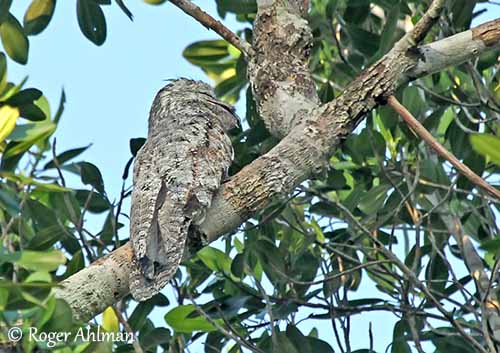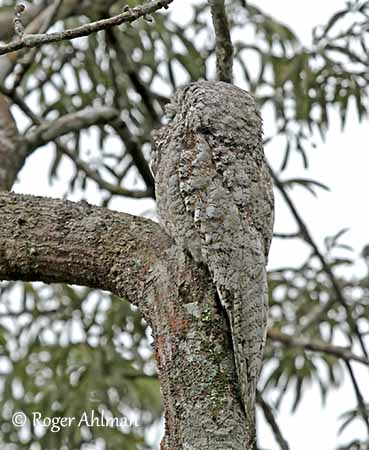
Fr: Grand ibijau
Ang: Great Potoo
All: Riesentagschläfer
Esp: Nictibio Grande
Ita: Nittibio maggiore
Nd: Vale Reuzennachtzwaluw
Sd: större poto
Port (Brésil): Mãe-da-lua-gigante
Photographers:
Roger Ahlman
Pbase Galleries Peru and Ecuador
Jean Michel Fenerole
Photos d’Oiseaux du monde
Ken Havard
My Bird Gallery & Flickr gallery 1 & Flickr gallery 2
Patrick Ingremau
TAMANDUA
Text by Nicole Bouglouan
Sources:
HANDBOOK OF THE BIRDS OF THE WORLD Vol 5 by Josep del Hoyo-Andrew Elliott-Jordi Sargatal - Lynx Edicions - ISBN: 8487334253
NIGHTJARS - A Guide to Nightjars and Related Nightbirds – Nigel Cleere and Dave Nurney - Yale University Press - First Edition (August 11, 1998) - ISBN 10: 0300074573 / ISBN 13: 9780300074574
A GUIDE TO THE BIRDS OF MEXICO AND NORTHERN CENTRAL AMERICA by Steve N. G. Howell, Sophie Webb - Oxford University Press - ISBN: 0198540124
A GUIDE TO THE BIRDS OF COLOMBIA by Steven L. Hilty and William L. Brown - Princeton University Press – ISBN 069108372X
BirdLife International (BirdLife International)
Animal Diversity Web (University of Michigan Museum of Zoology)
Neotropical Birds – Cornell Lab of Ornithology
SORA Searchable Ornithological Research Archive (Blair O. Wolf)
Wikipedia, the free encyclopaedia
Great Potoo
Nyctibius grandis
Caprimulgiformes Order – Nyctibiidae Family
INTRODUCTION :
This strange-looking bird takes advantage of its cryptic plumage to escape our eyes. In addition, its usual motionless posture while perching in tree makes it invisible. Its plumage is very similar to the bark.
The Great Potoo is a nocturnal predatory species and feeds primarily on insects caught by sallying from exposed arboreal perches.
Potoos are endemic to the Neotropics and are an ancient lineage once more widespread than at present.
The genus Nyctibius includes seven species and the Great Potoo is the largest one.

DESCRIPTION OF THE BIRD:
Biometrics:
Length: 48-58 cm
Wingspan: 73 cm
Weight: 500-620 g
The adult is large with pale (whitish) appearance overall. It is the palest and more variable species in colour, and the plumage may range from buffy-brown to whitish.
The upperparts are greyish-white to brownish, and finely vermiculated blackish and buff. The scapulars are darker. The tail is greyish-white with 8-9 dark bars, sharply bordered black. The wings are barred too.
The underparts are mostly whitish with fine dark bars and vermiculations. The breast shows a broken band formed by some blackish spots.
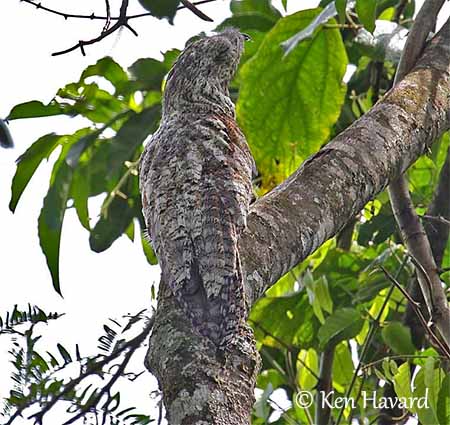
The head is large in relation to the body. Crown and nape are finely vermiculated.
The short bill has very short culmen and wide gape. The upper mandible has tooth-like projection at tip, very useful for hunting. The large eyes are light brown to yellow, but at night, they appear red or orange. Legs and feet are small and weak and are only used for perching on branches.
Male and female are similar.
The juvenile is almost pure white.
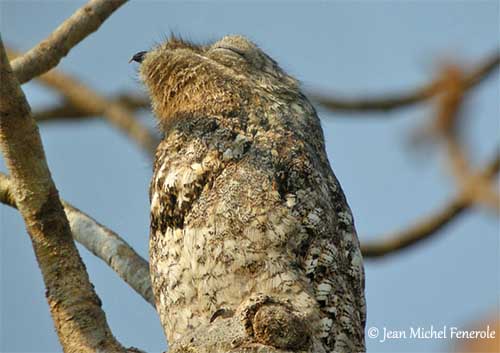
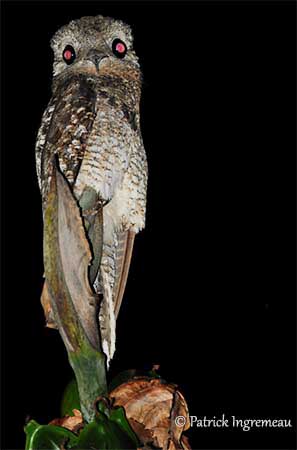
SUBSPECIES AND RANGE:
The Great Potoo has two subspecies.
N.g. guatemalensis (not displayed) is found in extreme S Mexico and Guatemala, and possibly Honduras.
This race has longer wings and tail than nominate. The back is richer brown and less vermiculated dusky.
N.g. grandis (described and displayed) is found in Nicaragua, S to N South America, mostly E of the Andes throughout Amazonia to N Paraguay, and in SE Brazil. It may occur locally between Amazonia and Atlantic Forest regions.
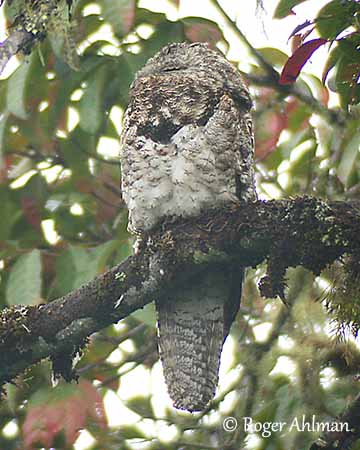
HABITAT:
The Great Potoo frequents primarily forest and rainforest, forest edge habitats and farmlands. During the day, it often perches motionless in large trees, at least 12 metres above the ground. But at night, it moves to lower perches, around 1,50 metre, from which it hunts. It may venture into clearings and also forages in open areas near forest.
This species usually occurs around 400 metres of elevation, but it can be seen up to 1000 metres in Peru and Bolivia.
CALLS AND SONGS: SOUNDS BY XENO-CANTO
The Great Potoo gives guttural growl “gra-a-a” and fairly similar harsh, grating “wah-h-h oo-oo-oo”. Other cries such as a drawn-out “awhrrr”, a groaning “rroh-rr” and a deep, owl-like “who-who” can be heard too.
The song is a harsh, strangulated “kwaaahw” or “baahoo” sometimes followed by shorter note “borr-bor”. This song is usually repeated several times at 10-20 second intervals.
The Great Potoo calls most frequently on moonlit nights.
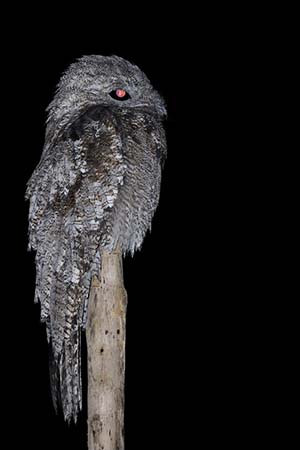
BEHAVIOUR IN THE WILD:
The Great Potoo feeds on flying insects caught by sallying from exposed perches. It flies up into the air, catches the prey and returns to a perch, often the same. Sallies are usually initiated from arboreal perches and never from the ground.
It also pursues the prey in flight and can be very acrobatic, even in the dense forest.
The preys include various insects such as Coleoptera and Orthoptera, and other insect species. Small bats are sometimes taken too. The preys are engulfed whole while flying, thanks to the large gape and mouth.
The Great Potoo forages at dusk and at night in the forest canopy, often 8-10 metres above the ground or more. At night, it may use lower posts, around 1,50 metre above the ground in clearings. The bird returns usually to the same perch after each attack.
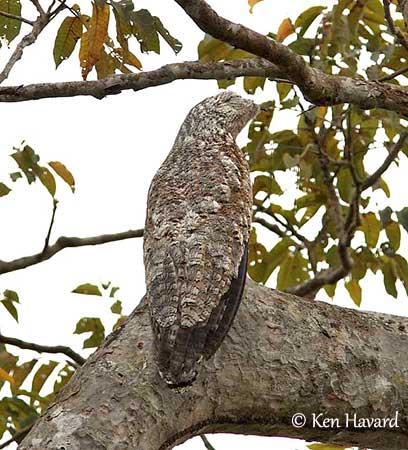
During the day, it is quiet, often perched on large branch in tall tree. The bird is motionless and its cryptic plumage is a perfect camouflage against the bark of the trunk. The large eyes are closed, but not completely, and only a narrow slit is visible. During the nesting period, movements are reduced to a minimum and only related to nest and chick protection.
The Great Potoo is a solitary bird except during the breeding season.
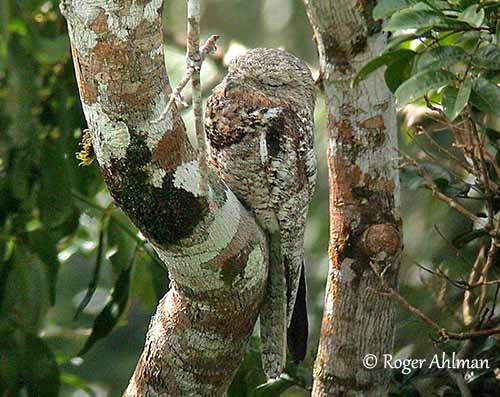
They are monogamous with probably long-term pair-bonds, as they maintain their territories for long time. Two singing birds, probably a pair, can be often heard at night while singing in the same area. However, mates are rarely seen together, even near the nest.
Due to their nocturnal habits, their cryptic plumage and their secretive behaviour in the canopy of dense forests, these birds are difficult to observe and to study, and more information is required, especially about their breeding behaviour.
The Great Potoo is sedentary in its range.
The flight is powerful, with fairly slow, deep wingbeats.
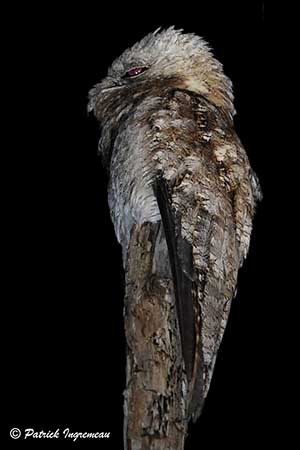
REPRODUCTION OF THIS SPECIES:
The nesting apparently occurs all year round, but mainly between February and August.
The Great Potoo does not build a nest, but it uses a natural depression, a deep notch or a crevice in a large branch in the canopy, often high in tree, between 12 and 34 metres above the ground according to the tree species. The eggs can be laid in the scar left by a broken branch, or on top of a broken stub. There is no nesting material added.
The female lays a single white egg with dark blotches. The incubation lasts 30 days. The male usually incubates during the day and remains on the nest until the nightfall. Then, the female starts to incubate and remains at nest until dawn. Both parents often call softly during this period.
At hatching, the chick has all-white down, but at two weeks, some darker feathers appear on back and wings. The adults leave it for longer periods when it is 28-29 days old, and take turns for brooding it at night. The chick is fed only during the night by regurgitation. The young fledges about 55-60 days after hatching, but it moves around on the tree at one month old.
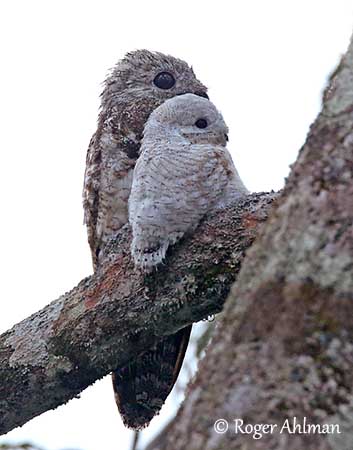
PROTECTION / THREATS / STATUS:
The main predators of the Great Potoo are monkeys and forest-falcons of genus Micrastur. The species is also affected by deforestation and burn farming.
However, the populations are estimated to be large, and placed in the band 500,000/4,999,999 individuals. Declines are suspected in some areas.
But currently, the Great Potoo is evaluated as Least Concern.
